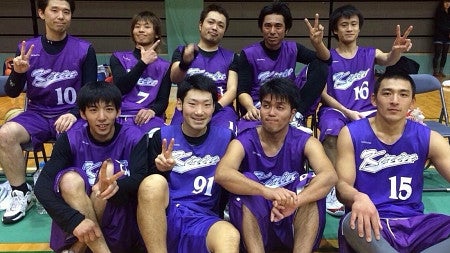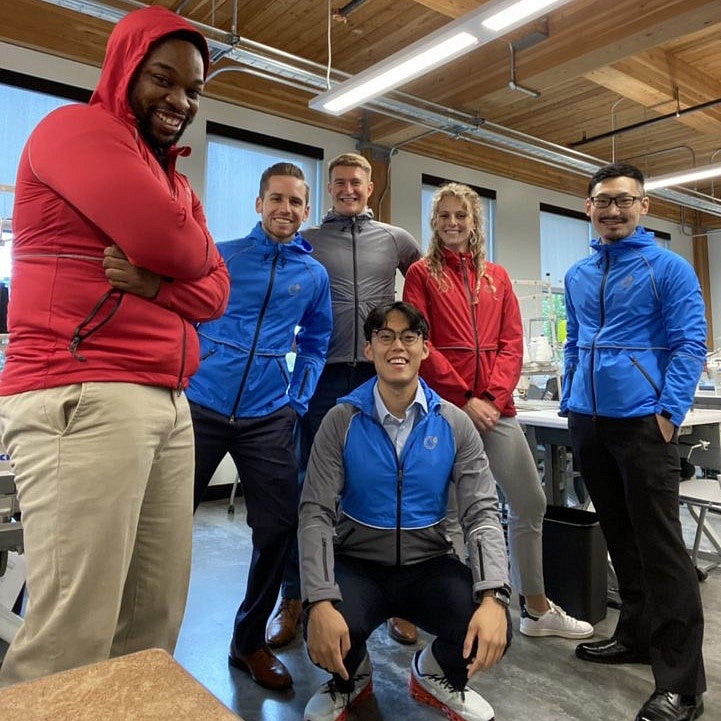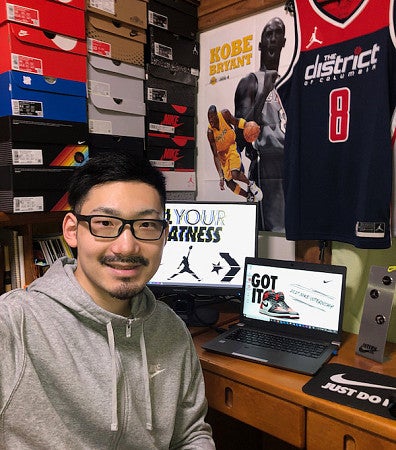Follow Yoshimi Saito through a typical week as a student in the Sports Product Management Portland program.
The University of Oregon Master of Science in Sports Product Management offers a one-of-a-kind education geared toward success in the sports and outdoor product industry. The program teaches the business of product creation with a strong focus on hands-on learning and networking with the industry, providing students the opportunity to advance their personal development and careers.
Yoshimi Saito, Class of 2022

Curiosity about footwear and tinkering with sneaker design is nothing new for Yoshimi Saito. One can easily look back to his childhood and see where the seeds of a future career in footwear product development were sown.
As a child in his native Japan, Saito could often be found running up and down a basketball court. He loved the outlet that basketball provided and the thrill of the snapping net when the ball passed cleanly through the iron. But for all the positives the sport brought him, something didn't quite feel right—literally. His feet were in a constant state of pain from ill-fitting shoes, and an activity that was meant to bring release instead became a source of discontent.
Not one to sit idly by, Saito began cycling through shoes on a quest for a solution. And one day, in a bit of a Cinderella moment, he found the perfect fit.
"It was like magic," Saito said. "I was curious why [these shoes fit better], so I looked into their product development and construction to see why."
It was this moment, combined with a family medical emergency and the realization that life is too short to not follow your dreams, that served as the catalyst for Saito to seek a career in the sports product industry.
"In the future I want to provide the same experience. I want to bring solutions to ordinary players so that they can be better versions of themselves in an athletic environment," Saito said.
Armed with skills obtained from several years working as a product inspector at a factory in Japan specializing in the fabrication of filters for things like oil, water and petrochemicals—as well as an appreciation of the English language and American culture from his time in the United States earning one of his two bachelor's degrees—Saito chose to enroll in the University of Oregon's Master of Science in Sports Product Management (SPM) program. In 2020, he and 44 other students from all around the globe joined the program's onsite cohort in Portland, Oregon—the North American hub of the sports product industry.
Upon completion of the 18-month program on March 2, 2022, Saito believes he'll have a competitive advantage over countless other professionals seeking to enter the sports product industry. He plans to join the accomplished list of 90 percent of graduates working in the industry and to become a pivotal member of a brand that brings solutions to ordinary athletes just like himself.
Monday: Group Work
Saito meets with his team to debrief on their weekend activities and provide any updates on the their project. During orientation, each SPM student is assigned to a team of approximately five to six members. Each team is tasked with using consumer insights to find a need in the sports product world, before ultimately ideating and creating a product solution. During this process, they’ll experience all of the industry machinations that brands like Nike or Adidas would in the real world in order to bring a product to market.
This team project is the backbone of the SPM curriculum. All classes provide the foundation and tools to address an opportunity area and bring a product to market, teaching students to carefully navigate the various channels of manufacturing and supply chain.

Saito’s team, which they've named "Ozone," is comprised of six members from various corners of the world, all with different career backgrounds and areas of expertise.
"My team is so diverse," Saito said. "Not only are we from all over the U.S. and world, but our backgrounds are unique. One team member has career experience in management and operations in youth sports, one in biomechanics and biochemistry, one in exercise science, another in marketing, and another is a college football player who has a background in environmental economics."
Ozone’s goal upon completion of the program is to bring its O3 running jacket to market. The jacket includes a drawcord-ventilation system and integrated waste pouch on the back of the jacket for personal belongings and solves the problem of runners who become overheated when wearing a rain jacket.
Throughout the length of the program, Saito and his teammates have interviewed target consumers, created prototype of various solutions in the program’s innovation lab, and communicated with factories in Asia in order to develop their jacket.
“The team project is a great experience,” Saito said. “On top of the actual development process, the creative team dynamic from all our backgrounds is like the real world. We all have insights from different angles. We’re not all just thinking in one straight line. We’re always providing multiple ways to achieve the same goal.”
Throughout the length of the program, Saito and his teammates have interviewed target consumers, created prototype of various solutions in the program’s innovation lab, and communicated with factories in Asia in order to develop their jacket.
“The team project is a great experience,” Saito said. “On top of the actual development process, the creative team dynamic from all our backgrounds is like the real world. We all have insights from different angles. We’re not all just thinking in one straight line. We’re always providing multiple ways to achieve the same goal.”

Team Ozone's jacket uncinched

Team Ozone's jacket cinched

Team Ozone wearing their jacket.
Tuesday: Lab Work

Tuesdays are a heavy lab day for Saito. He begins his morning by heading to the second floor of the program’s location on the scenic Portland waterfront. The elevator doors open to a pristine lab—the program’s pièce de résistance that is the envy of even industry professionals.
The innovation lab is full of state-of-the-art equipment, including more than 20 sewing machines, a laser cutter, and shoe bladder press—just to name a few. The closets are stocked with hundreds of different material samples that students can use for apparel projects or for designing their own pair of sneakers.
One of Saito’s favorite activities between classes or during off hours on the weekend is to come to the lab and learn about the different machines by working on his own personal projects. If he’s ever unsure of how to use something or needs some advice on how to advance his project, there’s usually a professor with decades of industry experience nearby to offer their insight.
“I like to build my portfolio and learn about the anatomy of the shoe,” Saito said. “The past 18 months I’ve been making shoes for myself like my own Air Force 1s. I set career goals every term that I need to make at least one pair of shoes… You can turn all your personal ideas and designs into actual products, which you can then use in the interview process to show what you did. It makes for a strong candidate.”
Wednesday: Classes
Following a busy day in the lab, the middle of the week brings a more traditional day of classroom learning led by leaders in the industry. During his time in the program, Saito has had classes on subjects such as product line management, product development, sustainability, and branding.

While the idea of a traditional lecture can conjure images of just sitting at a desk, scribbling down notes, there’s no such thing as a dull day in the program. Students never know when legendary Nike designer Tinker Hatfield might hop on a Zoom for a casual question and answer session with students, or when Wilson Smith will show up in person to deliver a spontaneous lecture about one of his recent projects designing equipment for athletes with disabilities.
It comes as no surprise that Saito’s favorite class is Product Development, taught by Nike Senior Innovator Elizabeth Brock-Jones. It’s here that Saito refined his knowledge of shoe anatomy, learned to turn 2D images into 3D realties, and built a tech pack that developers use to communicate with factories during the product creation process.
“EBJ really elevated the idea of product development and taught us how to be knowledgeable developers before we even get hired,” Saito said. “It allows me to set a life direction for my future career. It taught me the importance of really digging deep into the product and deconstructing the shoe. Her advice really inspired me to do it myself in the lab.”
Thursday: Project Work

"I want to bring solutions to ordinary players so that they can be better versions of themselves in an athletic environment."
The Sports Product Management program offers numerous opportunities that allow students to use what they learned in class and apply it firsthand within the industry. One such project, assigned toward the end of the onsite program’s 18-month timeline, places students in a new team for work with an established brand.
Saito and his group worked with Portland-based BALA Footwear, a manufacturer of footwear for nurses established by a team of veteran industry professionals. Saito’s team used the skills they learned in class to identify a particular problem that the company faces.
Using data from market research and interviews with nurses about the types of footwear they like to wear and for what reasons, the team then developed and presented a product idea for BALA to pursue. This hands-on experience not only provides students with the skills they’ll need in their future careers, but allows them to continue to grow their network as well.
Friday: Networking

Classes typically take place on Mondays through Thursdays, which leaves Fridays for one of the most important aspects of the program: networking.
Outside of personal connections developed through guest speaker sessions, market tours, and other networking events, each student is also assigned their own industry mentor.
Saito’s mentor, Jeffrey Lee, is a product line manager for global product licensing at Nike. Saito made sure to meet with Lee at least once a month to check in and glean career advice that he can use when he graduates and starts searching for his first job as a product developer.
Each student’s experience with their mentor is unique and completely voluntary. Students get as much out of it as they put into it— which for Saito is a lot. Saito’s dedication to learning from his mentor even led to one of his favorite interactions with industry professionals.
“My mentor, Jeffrey, organized a meeting with me that included a bunch of his team members at Nike, and then we got to know each other,” Saito said. “He allowed me to see the product he was in charge of, and then we went market shopping. He took me to retail—the Nike factory store and wholesale stores—to show me how his product was actually being presented and the importance of having a consistent story within the product line, no matter where you sell it. It’s great exposure, and you can learn first-hand about what is important in the industry.”
In addition to industry connections gained through mentorship, students have even more opportunities to network during their required summer industry internship. Saito was able to use the knowledge he gained in the SPM program—as well as advice from his mentor—during his own internship with Nike’s offices in his home country of Japan.
Weekends: Exploring Portland
The weekends are spent studying, working on personal and academic projects, and experiencing the many pleasantries of the Portland area. SPM students can often be found grabbing a cup of coffee at one of the numerous local coffee shops or even making the short walk across the steel bridge over the Willamette River to attend a Portland Trail Blazers basketball game.
This "Week in the Life" content was written and developed by Thomas Schlarp, SPM Portland program, class of 2023.

